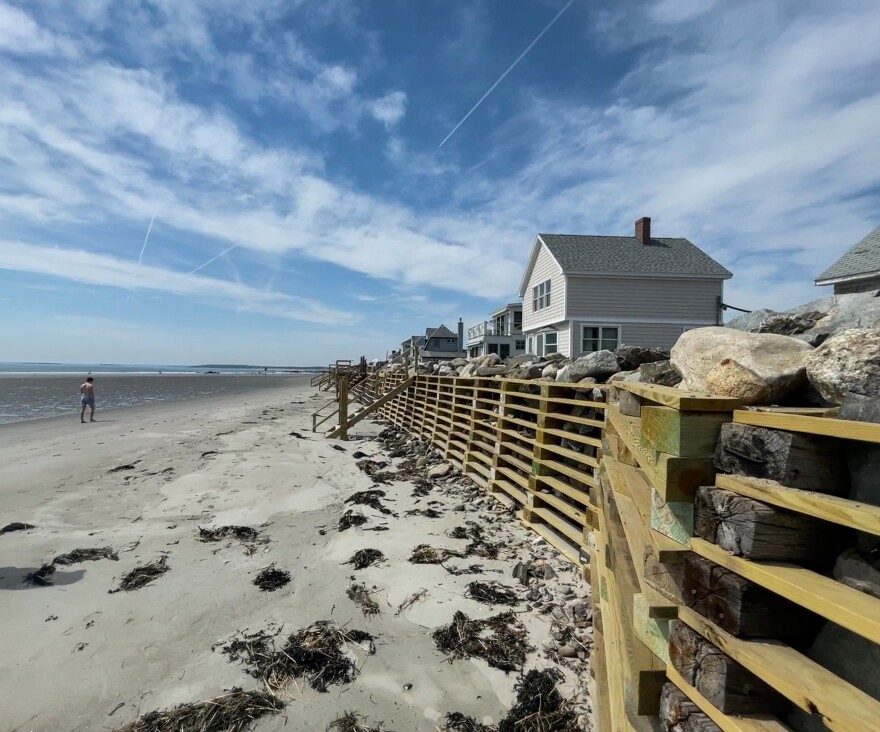Higgins Beach in Scarborough is lined with private homes and cottages. But Peter Slovinsky of the Maine Geological Survey says 100 years ago, there was a lot more beach to enjoy.
“If we were looking at historical pictures of this area, back in the teens, twenties and thirties, we’d be looking at some cottages behind a pretty expansive dune system, and then a pretty wide sandy beach, and the shoreline would have been a couple of hundred feet further seaward than it is right now," he says.
Now, at high tide, you can't walk much of the beach without getting your feet wet, as the ocean laps up against sea walls that homeowners have built to keep their houses from washing away. This phenomenon is known as coastal squeeze.

This story is part of our series "Climate Driven: A deep dive into Maine's response, one county at a time."
The acceleration of sea level rise due to climate change has prompted some analysts to predict a decline in the value of waterfront properties. But that hasn't happened in Maine. In fact, the value of beachfront houses has skyrocketed. Part of the reason may be that people simply love to live on the water, and can afford to. And for some, the risks of rising seas and more powerful storms just don't seem all that imminent.
Scientists predict Maine sea levels will rise by about a foot and a half in the next 25 years. And Slovinsky says on most beaches the waterline will move about 100 feet inland with each foot of sea level rise. But none of this appears to be having much of an effect on real estate values.
“Maine is becoming more and more desirable for people to live for a variety of reasons," says real estate agent Scott Townsend, "and if you can afford it, there is nothing better than being oceanfront.”

Townsend says he began visiting his grandmother here when he was a baby. He and his wife were married on the beach. Now they sell houses in the area, and manage more than 100 rentals. Townsend says he understands the challenges posed by the changing climate and rising sea levels.
"It’s a constant battle," he says. "And I think at the end of the day, if you were to fast-forward 200 years from now, when none of us will be around, the ocean is going to win, at the end of the day.”
But in the nearer term, Townsend says beachfront houses rarely hit the market, and when they do, they are snapped up in a heartbeat. In fact, Townsend says a tear-down several blocks inland from this beach would likely sell for more than a million dollars, and a beachfront house would be far more expensive. Even so, many buyers see waterfront property in Maine as a steal.
"Without a doubt, they think that's a bargain," says Cale Pickford, who specializes in oceanfront insurance policies for Allen Insurance and Financial in Camden. "They can't believe the quality and affordability of Maine real estate."
Pickford says the market is driven by out-of-state buyers, and coastal real estate in Maine is far cheaper than it is on Cape Cod, or Martha's Vineyard, or in California. Pickford says homeowner's insurance policies for his clients are more expensive than for a house that's high and dry, but aren't prohibitive for people who can afford the houses.
And Pickford says even the climate risks here in Maine seem less ominous than in other coastal states.
"I don't think that people are as aware of the sort of slow-moving and creeping risks of climate change to the coast of Maine," he says. "When you weigh that against the extreme weather events in California where you have wildfires, and Florida where you have devastating hurricanes, and Texas where you're going to have tornadoes and hailstorms. We just aren't making the news, it's not quite as sensational. So, relative to those areas, people see Maine as a safe place."

And Rick Hartz, who owns a beachfront home on Higgins Beach, likes the odds, based on a risk assessment from his insurance company.
"What they told us was there is now only a 2% chance that your house will be torn down to due to rising water or a major storm, 2% chance in the next one hundred years," he says.
Several years ago, Hartz bought a cottage, tore it down and built a new house. It's perched on pilings more than six-feet tall, and meets Scarborough's stringent flood zone ordinance. He and his wife and four children come up from Pennsylvania to spend summers on the beach, and he says the 100-year projection puts him at ease.
"That's our kids, that's our grandchildren, that's our grandchildren's children," he says. "We feel confident that we still have many generations left before we would face any sort of issue."
Back on Higgins Beach, Peter Slovinksy of the Maine Geological Survey points out the fresh crib work on sea walls that had to be rebuilt after the big storm in late December. Eventually, he thinks, something will have to give.
“There’s probably going to become a point where a decision needs to be made whether or not infrastructure is worth keeping where it is," Slovinsky says. "Or in some cases maybe it needs to be adapted, it needs to be elevated. A lot of these homes we seen here have been elevated when they’ve been rebuilt, so they are now more resilient. But that doesn’t solve the coastal squeeze problem that we are talking about. Where you do have a solid structure still in the way of a dynamic system trying to migrate inland in response to storms and sea level rise.”
For now, it seems, the only thing rising faster than the sea is the price of waterfront houses. And neither show any sign of relenting.




